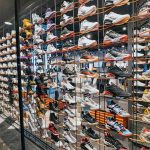PUMA AG rode the market even higher last week, with company shares more than doubling in the past year. Shares peaked last week at 212.70 before closing at 210.90, up 6.8% for the week and up more than 46% since the first of the year. The companys market value has risen to 3.38 billion ($4.0 bn). The company has kicked off yet another strong year, posting solid sales and earnings increases and posting an order backlog book that has prompted the company to raise guidance for the year.
The company posted a consolidated net sales increase of 29.3% to 443.8 million ($554.4 mm) versus 343.2 million (368.2 mm) last year. On a currency-neutral basis, sales were up 33.2%. Total organic growth, or that growth achieved without the inclusion of the acquired PUMA Japan operation, was up 21%, or 24.9% on a currency-adjusted basis.
Apparel sales momentum was said to have “continued on a very high level”, reporting organic growth of 39.1% to 111.2 million ($138.9 mm). Footwear sales grew by 22.7% to 305.9 million ($382.1 mm) and Accessories increased 90.9% to 26.7 million ($33.4 mm). Organic growth for FW was up 18.3% and Accessories was up 30.6%, currency-adjusted.
Total sales in Europe were up by 22.9% to 313.6 million ($391.8 mm), representing 70.7% of consolidated sales vs. 255.3 million ($273.9 mm) or 74.4% in Q1 of last year. Apparel had the strongest growth rate at 42.2% over last years Q1 numbers. Footwear increased 16.8% in the region and Accessories delivered a strong double-digit gain of 22.8% for the quarter. GM jumped from 50.9% to 54.7% hitting a new all-time high.
The Americas grew 9.2% in Euro terms to 72.8 million ($90.9 mm) in the quarter. All product segments were said to have contributed with double-digit increases to the overall performance. Gross margin improved 50 basis points to 44.8% versus 44.3% last year. Sales in the U.S. market increased 16.7% to $74.3 million in Q1 from $63.6 million in the year-ago quarter.
Asia-Pacific posted a 250% increase in sales for the period due largely to the inclusion of Japan as a company subsidiary this year. Sales were up from 12.7 million ($13.6 mm) to 44.5 million ($55.6 mm). Excluding Japans, sales increased 26.4% to 15.9 million ($19.9 mm), or rose 13.4% on a currency-adjusted basis.
PUMAs global branded sales, which include consolidated sales and licensee sales, reached 549.3 million ($686.2 mm), posting a 21.8% increase over last year. The currency-adjusted growth was up 25.1%. Gross profit margins hit a new record at 51.7% of sales compared to 47.2% in last years first quarter, an increase of 450 basis points. The dollars impact on sourcing added 340 basis points of the improvement, while owned-retail contributed most of the balance of the gain. Footwear margin climbed 490 basis points to 52.9% in Q1 from 48.0% in the year-ago period and Apparel margins rose 420 basis points to 49.4% from 45.2% last year, while the Accessories GM remained flat at 46.1%.
Net earnings were up by 64.6% to 80.4 million ($100.4 mm) in Q1 from 48.8 million ($52.4 mm) in the year-ago quarter. Diluted earnings per share were up nearly 89% from 3.02 ($3.24) in Q1 LY to 4.90 ($6.12) in first quarter 2004.
Looking ahead, Puma marked its 33rd consecutive quarter of backlog order growth, posting a 20.1% increase in backlog at quarter-end to a new record high of 776.6 million ($945.7 mm). Excluding Japan, orders were up by 24.5% in Euro or 28.3% currency-adjusted. The Europe order book increased by 25.7% to 552.1 million ($648.7 mm) and futures in the Americas were up 10.3% in Euro terms to 122.5 million ($149.2 million). The Asia-Pacific order book actually dipped compared with last year, due mainly to a “streamlining of the product range and distribution” to better align with the corporate model. U.S. backlog orders for the next six months were up 22.6% at the end of the quarter to $139.5 million.
Based on the stronger-than-expected results, PUMA is increasing guidance for the full year, while still focusing on controlled growth. Sales are now expected to grow in the 15% to 20% range. Gross margin is expected to exceed 50% for the year and EBT is forecast to grow 30% versus 2003, based on “positive currency hedging” of U.S. dollar-based sourcing and continued expansion of the owned-retail business.















